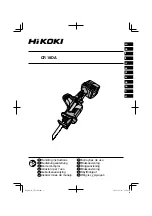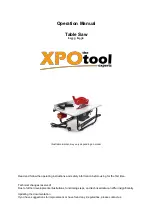
5
CAUTION
䡬
When cutting at low speed (scale of 1 – 2), never cut a
wooden board more than 10 mm thick or a mild steel
plate more than 2 mm thick. The load on the motor
can result in overheating and damage.
䡬
Although this unit employs a powerful motor,
prolonged use at a low speed will increase the load
unduly and may lead to overheating. Properly adjust
the saw blade to allow steady, smooth cutting
operation, avoiding any unreasonable use such as
sudden stops during cutting operation.
HOW TO USE
CAUTION
䡬
Avoid carrying it plugged to the outlet with your finger
on the switch. A sudden startup can result in an
unexpected injury.
䡬
Be careful not to let sawdust, earth, moisture, etc.,
enter the inside of the machine through the plunger
section during operation. If sawdust and the like
accumulate in the plunger section, always clean it
before use.
䡬
Do not remove the front cover (refer to
Fig. 1
).
Be sure to hold the body from the top of the front
cover.
䡬
During use, press the base against the material while
cutting.
Vibration can damage the saw blade if the base is not
pressed firmly against the workpiece.
Furthermore, a tip of the saw blade can sometimes
contact the inner wall of the pipe, damaging the saw
blade.
䡬
Select a saw blade of the most appropriate length.
Ideally, the length protruding from the base of the
saw blade after subtracting the stroke quantity should
be larger than the material (see
Fig. 15
and
Fig. 16
).
Fig. 15
Fig. 16
If you cut a large pipe, large block of wood, etc., that
exceeds the cutting capacity of a blade; there is a risk
that the blade may contact with the inner wall of the
pipe, wood, etc., resulting in damage. (
Fig. 17
,
Fig. 18
)
Fig. 17
Fig. 18
䡬
To maximize cutting efficiency for the materials you
are using and working conditions, adjust the speed
of the saw blade.
1. Cutting metallic materials
CAUTION
䡬
Press the base firmly against the workpiece.
䡬
Never apply any unreasonable force to the saw blade
when cutting. Doing so can easily break the blade.
(1) Fasten a workpiece firmly before operation. (
Fig. 19
)
Fig. 19
Example of materials
Recommended
to be cut
dial scale
Mild steel pipes /
cast-iron tubes /
2 – 4
L-shaped angle steel
Wood / wood with nails
driven in
5
Stainless steel
1 – 3
Aluminum / brass / copper
2 – 4
Plaster board
4 – 5
Plastic / fiber board
1 – 3
Stroke
Stroke
;;;;;;;;;;;
;;;;;;;;;;;
;;;;;;;;;;;
;;;;;;;;;;;
;;;;;;;;;;;
;;;;;;;;;;;
;;;;;;;;;;;
;;;;;;;;;;;
;;;;;;;;;;;
;;;;;;;;;;;
;;;;;;;;;;;
;;;;;;;;;;;
;;;;;;;;;;;
;;;;;;;;;;;
;;;;;;;;;;;
;;;;;;;;;;;
;;;;;;;;;;;
;;;;;;;;;;;
;;;;;;;;;;;
;;;;;;;;;;;
;;;;;;;;;;;
;;;;;;;;;;;
;;;;;;;;;;;
;;;;;;;;;;;
;;;;;;;;;;;
;;;;;;;;;;;
;;;;;;;;;;;
;;;;;;;;;;;
;;;;;;;;;;;
;;;;;;;;;;;
;;;;;;;;;;;
;;;;;;;;;;;
;;;;;;;;;;;
;;;;;;;;;;;
;;;;;;;;;;;
;;;;;;;;;;;
;;;;;;;;;;;
;;;;;;;;;;;
;;;;;;;;;;;
;;;;;;;;;;;
;;;;;;;;;;;
;;;;;;;;;;;
;;;;;;;;;;;
;;;;;;;;;;;
Содержание CR13VC
Страница 11: ...10 ...
Страница 12: ...305 Code No C99117211 N Printed in Japan Hitachi Koki Co Ltd ...






























